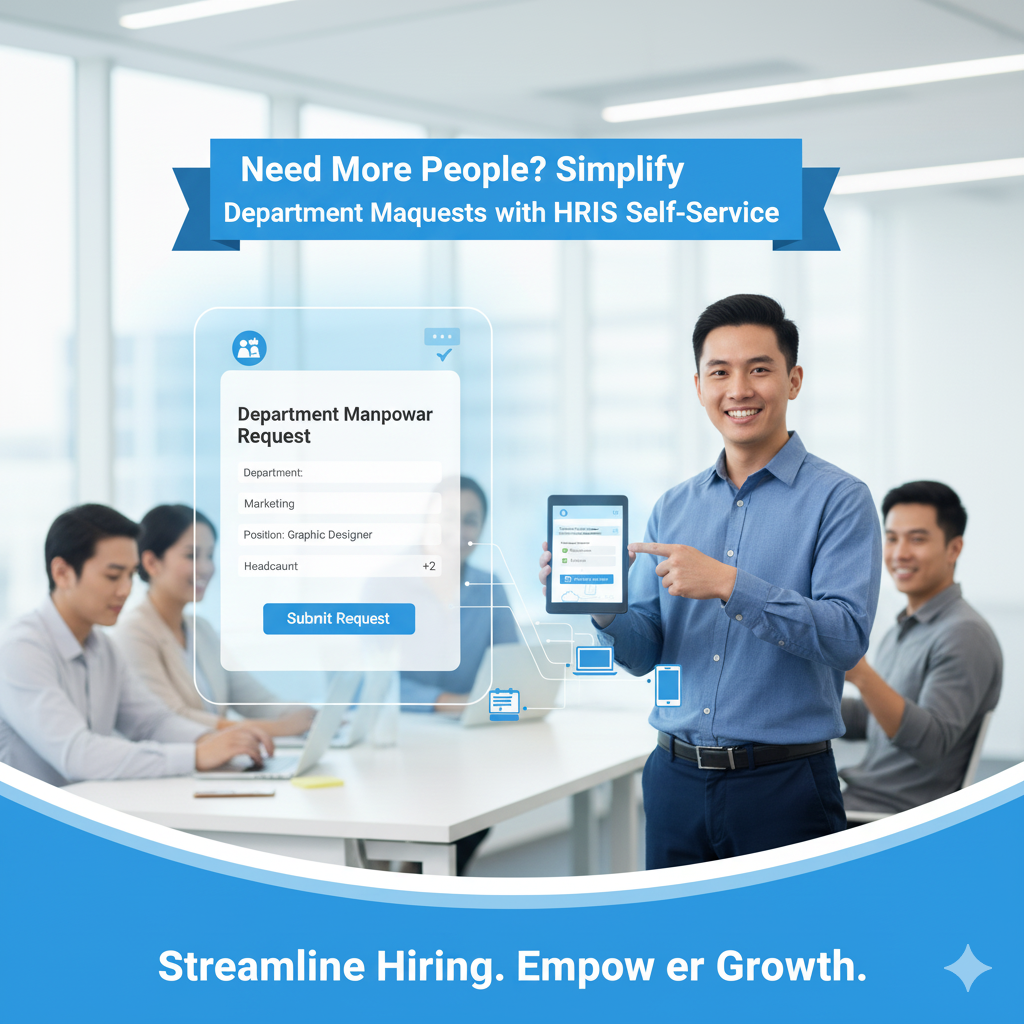Every growing organization faces one common challenge — ensuring that each department has the right manpower at the right time. Whether it’s to fill a vacancy, expand a team, or meet project demands, processing manpower requests often involves multiple approvals, manual documentation, and time-consuming coordination.
Enter the HRIS Self-Service Department Manpower Request — a modern solution that allows managers to request additional staff directly through the Human Resource Information System (HRIS). This streamlined process not only speeds up hiring decisions but also provides HR teams with better visibility, accuracy, and control over workforce planning.
In this article, we’ll explore how HRIS self-service simplifies department manpower requests and why it’s a must-have feature for forward-thinking organizations.
What Is a Department Manpower Request?
A Department Manpower Request (DMR) is an internal process where managers formally request to hire new employees or replace existing ones. These requests typically include details like:
- Job title and position level
- Reason for hiring (e.g., new role, replacement, project expansion)
- Required skills or qualifications
- Budget approval and timeline
Traditionally, this process involved manual paperwork or lengthy email chains — making it prone to delays, lost documents, and miscommunication between HR and department heads.
The Role of HRIS Self-Service in Manpower Requests
With an HRIS self-service system, department heads can now file manpower requests digitally within the company’s HR platform. The system automatically routes the request to the appropriate approvers, tracks progress, and notifies stakeholders in real time.
This eliminates the need for back-and-forth emails and allows HR teams to monitor manpower demand efficiently.
How HRIS Self-Service Simplifies Department Manpower Requests
- Easy and Fast Request Submission
Managers can log in to the HRIS portal, fill out a simple form specifying the position, justification, and preferred timeline — all within minutes. The standardized format ensures all essential details are captured upfront, reducing the risk of incomplete or unclear requests. - Automated Approval Workflow
Once submitted, the system automatically routes the request to the relevant approvers — whether it’s HR, finance, or top management. Approvers receive notifications, review requests digitally, and approve or reject them with a single click.
This automation speeds up decision-making and ensures every request follows the correct chain of command. - Real-Time Tracking and Transparency
With HRIS self-service, both HR and department heads can track the status of each manpower request in real time. This transparency eliminates guesswork, reduces follow-ups, and ensures accountability at every step of the process. - Better Workforce Planning
The HRIS system records all manpower requests, approvals, and outcomes in a centralized database. HR teams can use this data to analyze hiring trends, forecast staffing needs, and plan future recruitment strategies more effectively. - Integration with Recruitment and Budget Modules
A strong HRIS platform connects the manpower request feature with recruitment, payroll, and budgeting modules. Once approved, the system can automatically trigger a recruitment requisition, ensuring that hiring begins promptly and stays within approved budgets.
Key Benefits of HRIS Self-Service Manpower Requests
| Benefit | Description |
| Efficiency | Eliminates manual paperwork and accelerates the approval process |
| Accuracy | Reduces human errors by standardizing request forms |
| Visibility | Provides HR and management with real-time manpower data |
| Accountability | Creates digital audit trails for every request and approval |
| Empowerment | Enables managers to take ownership of their team’s staffing needs |
Best Practices for Implementing Self-Service Manpower Requests
- Define Clear Policies – Establish guidelines for when and how to file manpower requests, including required justifications and approval hierarchies.
- Provide System Training – Ensure managers and approvers are trained to use the HRIS platform efficiently.
- Integrate with Other HR Modules – Connect manpower requests to recruitment and payroll systems for seamless processing.
- Monitor and Analyze Trends – Regularly review data to identify recurring staffing needs or bottlenecks in the approval process.
- Encourage Data-Driven Decisions – Use manpower analytics to align staffing with organizational goals.
The Impact on HR and Department Managers
By adopting HRIS self-service manpower requests, HR departments gain valuable insights into workforce demand patterns while managers gain autonomy to act quickly when new staffing needs arise.
The result?
✅ Faster hiring decisions
✅ Reduced administrative burden
✅ Greater transparency
✅ Improved alignment between HR and business goals
Ultimately, this digital transformation fosters a more agile, data-driven, and collaborative workplace culture.
Conclusion
In a dynamic business environment, speed and accuracy in manpower planning can make all the difference. HRIS self-service empowers department heads to request manpower seamlessly, while HR teams maintain control and visibility over staffing operations.
By simplifying and automating manpower requests, organizations can ensure that the right people are in the right roles at the right time — driving efficiency, productivity, and growth.
If your company still relies on manual manpower request forms, now is the perfect time to embrace HRIS self-service and modernize your workforce management process.

